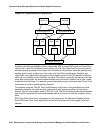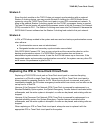
Communication Manager Maintenance-Object Repair Procedures
2336 Maintenance Procedures for Avaya Communication Manager 3.0, Media Gateways and Servers
3. A particular Tone-Clock circuit pack can be made active by issuing the set tone-clock
location [override] command. If the Tone-Clock to be made active is less healthy
than the currently active one, no interchange will occur unless the override option is
specified; without it a message will inform the user that it is required.
Once a Tone-Clock circuit pack is made active by the set tone-clock location
command, it will stay active until either the set tone-clock location command is
entered again to make the other circuit pack active, or until a fault occurs in the active
Tone-Clock circuit pack, which causes the system to interchange Tone-Clocks.
S8700 | 8710 / S8500
Firmware Instigated Tone-Clock Interchanges
Firmware-initiated Tone-Clock interchanges occur when the auto clock switching option is
enabled, and the TN2312 IPSI circuit pack firmware detects a loss of clock or clock errors. After
detecting a loss of clock/clock errors, and rather than waiting for system software to request a
switch, the IPSI firmware will automatically switch the clock (when auto clock switching is
enabled). The auto clock switching option is disabled during system restarts.
Note:
Note: The auto clock switching option is required by the IPSI circuit pack since the EAL
connection to the PKT-INT (one of the IPSI circuit packs many functions) is over
the server packet bus which must have a good clock for proper operation.
S8700 MC
Clock Synchronization
Note:
Note: Stratum-3 clocking is not available for a port network supported by a TN2312
(IPSI) circuit pack, or a port network where the Tone-Clock function is supplied by
a TN2182.
This section discusses synchronization with a Stratum-3 or -4 clocking device.


















